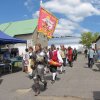July 2019 newsletter

In these newsletters, I usually report on the weather in the previous month. That used to be easy enough, but two years ago my workplace was moved into a prizewinning new office building with a grey plastic sheet wrapped round its exterior. Apart from its prizewinning aesthetic properties, the grey plastic provides sound and heat insulation, and it also prevents us workers wasting our employers’ time by looking out at what might otherwise have been a good view. We get very little impression of the meteorological conditions. I can deduce whether it is windy (movement of treetops?) or whether it is raining (streets wet? people at the tram stop using umbrellas?). Temperature is more difficult to deduce. After two years in this building, I am beginning to think the architect was a wise man: the weather conditions are irrelevant to a man like me. Why worry about the ‘real world’ out there when I can live in this prizewinning grey bubble!
I read that June 26th was the hottest day, 38.9 degrees, ever recorded in June in the Czech Republic. That temperature was recorded at Doksany, which is near to the Prague – Dresden motorway, at about the point where a straight line between Most racecourse and Mimoň racecourse would intersect the motorway. Due to the air conditioning in the office I felt a bit chilled on that day, to tell the truth. A second layer of clothing would have solved that problem, of course. I suppose I could even have adjusted the thermostat on the air conditioning.
I think the weather until the last week of June was generally mild, with a reasonable amount of rain. The last week of the month has been very hot and very dry. As I have frequently mentioned on these pages, our racecourses generally suffer from dryness and from rapidly-sinking water tables. Our major racecourses have adequate irrigation systems for the flat racing circuit, but it really is not possible to irrigate the crosscountry steeplechase circuits enough to get them into good condition.
I checked the official going at the 23 race meetings held in the Czech Republic in April, May and the first 29 days of June, and found that it was either good or good-to-firm at every meeting except one. The sole exception was at Slušovice on May 8th, when the official going was 4.8 soft. Karlovy Vary is the only Czech racecourse at which soft ground is quite often recorded. In the good old days, Prague Velká Chuchle racecourse was closed down in July and most of August, and the racehorses based at the racecourse in Prague were sent to Karlovy Vary to train and race there in the summer months in cooler conditions and on softer ground than is available in Prague. Karlovy Vary racecourse is down by the river, and this wonderful spa town is often cooled by late afternoon thunderstorms in summer.
***
It has been strange to go racing here for the past three months without free access to betting. Betino, which used to have a de-facto monopoly for on-course betting had the renewal of its licence delayed. We have now been informed that Betino will be offering odds as from Friday, July 12th, when there will be evening racing at Prague Velká Chuchle. People around Czech racing have been irritated by the delayed issue of Betino’s licence to take bets. On the one hand, I have been irritated too. What is the point of Category IV and Category V races if you cannot have a bet on them! On the other hand, I can understand why the Czech government wants to try to get a grip on the gambling industry, and ensure that it pays some tax, and does not operate in a disorderly way and facilitate money laundering and tax avoidance. However, I’m not at all sure the Czech government and the Ministry of Finance are clever enough to stop the gambling industry preying on addicts, avoiding taxation and laundering money.
The main problem is not horseracing and is not little Betino – it is offshore and online gambling, on football, on slot machines, on numbers games, in casinos, etc. Betting on horseracing is unfortunately classified under the law on lotteries, together with other forms of gambling. Czech horseracing perhaps lacks someone who can have a quiet word with the prime minister, or with the minister, and explain to them what is needed for betting on horseracing, and why it is a special case. More likely, the problem is that the prime minister and the minister do not want to listen.
I hope that Friday evening racing and Betino betting will attract a good crowd on July 12th. I have for a long time hoped that Prague Velká Chuchle would again try offering evening racing on weekdays in June and July, and that good crowds would turn out for them. The racecourse is very accessible from central Prague and from the south and east, and a warm July evening at the racecourse might appeal to plenty of people. I certainly hope it will.
***
I reported on these pages recently http://www.dostihovy-svet.cz/en/node/8514 that the Czech Ministry of Agriculture has contributed 5 million crowns to the Town of Pardubice in support of horseracing at Pardubice racecourse. The sum of 5 million crowns is equal to the prizemoney for the Velka Pardubicka. However, it was suggested in the announcement that the money is not exactly intended for sponsoring the VP itself. The financial support was a contribution towards “ensuring the quality of the programme and retaining one of the most prestigious horse races in Europe, which is inherently linked with the Czech Republic.” In my opinion, it would be a pity to blow all the money on sponsoring the Velka Pardubicka. The Velka is our Grand National – it must be possible for the racecourse to find some kind of sponsor for a race that will be the talk of the country for 10 days before it is run, on October 13th, and for a few days after the race. The Velka is the climax of a six-and-a-half hour programme on Czech Television on October 13th. It may not be easy to find sponsors for races here, but the racecourse management has to find a way to get a sponsor for the Velka. That is a central task of the Pardubice racecourse managers.
***
There is always plenty of discussion here about the state of Czech horseracing. The number of horses in training and the number of two-year-olds racing here has gone down gradually for many years. No individual year-on-year drop has been particularly alarming, but when we compare numbers now with numbers 15 years ago, the decrease is a matter for concern. We are expecting a rise in the number of 2-y-os this year for the first time in many years. However, the number of race days in the Czech Republic will be lower this year than for many years. This is partly due to the smaller number of horses in training here, and partly due to the ever-increasing numbers of horses trained here and raced entirely or mainly abroad. In addition, the racecourses want to have larger fields for their races, and it does seem logical for them to achieve this by offering fewer races and fewer race days.
***
In the commentary on the Hardwicke Stakes at Ascot, Nagano Gold was referred to as coming from a second-division horseracing country. It is of course true that race meetings in the Czech Republic cannot compare with France, England, Ireland and Germany, or with meetings in the other major horseracing countries. It is also true that the horse has raced here and is trained here by a Czech trainer. However, Václav Luka has been winning a lot of good races in France in the last 4 or 5 years with well-bred horses, most of them purchased in France, which he trains expertly. If a Luka-trained horse that is unknown to the local bookies runs at your local course, and you can get odds of 66 to 1 against it, you might be onto a good each-way bet.
Only 6 racedays are planned in the Czech Republic for July 2019. July used to be a month here for up-country racedays, but this year only one real upcountry racecourse is holding a meeting in July this year. I no longer include Lysá-nad-Labem, where there is a meeting on Saturday, July 6th, in the up-country category. Lysá is nowadays a pleasant suburban dormitory town with a nice suburban racecourse. Lysá has good rail and road links for people who work in Prague or in the numerous assembly plants that foreign and Czech companies set up in strategic places. That is, in places with good road and rail links, but far enough from the capital city to offer cheap land and cheap but sufficiently skilled labour.
The upcountry meeting is on Saturday, July 13th, at Světlá Hora. There is a major training centre at Světlá Hora, which is near Bruntál, in the hills north of Olomouc. The raceday at Světlá Hora is a local festival at what probably still is a well-maintained course. This will be the 27th annual race day and fair at Světlá Hora, which is a good effort in a part of the country that is far from the nearest racecourse. By train and bus, it is a fine day trip from Prague. Oaks day at Karlovy Vary is Sunday, July 21st, and there is a Friday evening meeting at Prague Velká Chuchle on July 12th. The other meetings are at Slušovice on Friday, July 5th, a public holiday, and at Most at the end of the month.
***
It was good to have Mark Buchan and Diane Hill visiting for the Derby day/VP qualification race weekend in June, and I hope to go racing with Martin Pennington next weekend. Greetings from the Czech Republic.
***
photo: fairground atmosphere at Světlá hora
